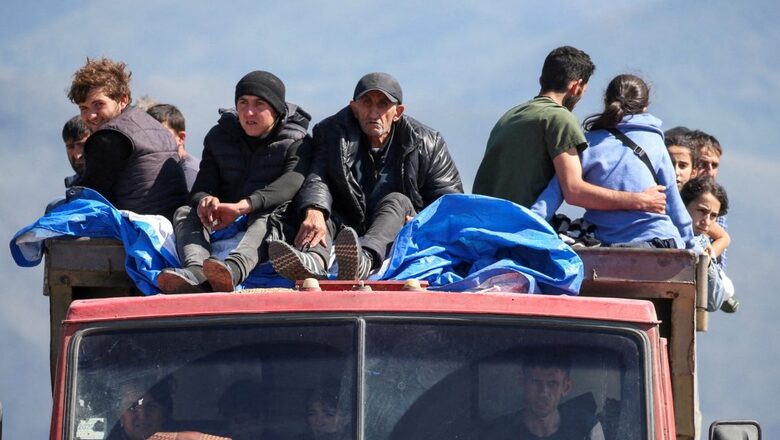
views
The third war over Nagorno-Karabakh, the long-disputed Armenian enclave within Azerbaijan, ended almost as soon as it began. The Azerbaijani ‘anti-terror operations’ began on the afternoon of September 19 with artillery and drones and within 24 hours, the Karabakh Armenians, a population that has been pushed to the brink of starvation by a months-long economic blockade, capitulated, leaving Azerbaijan in effective control of the territory.
In scenes reminiscent of the Balkans in the 1990s, images of convoys of cars filling the mountain road from Karabakh to Armenia carrying thousands of ethnic Armenians leaving their homeland with as much as they can carry are flooding cyberspace. A region that has witnessed many such upheavals over the years faces yet another round of de facto ethnic cleansing.
While the focus of the West continues to remain on Ukraine, there is a bigger long-term failure here, in their inability to prevent the violence and get the Armenians and Azerbaijanis to agree on an equitable resolution to this bitterly contested conflict.
For the local population, the pendulum has swung since the collapse of the Soviet Union from euphoria, siege, victory, defeat and this outcome marks a bitter end and the complete destruction of a project that began in 1988 when the Armenians of Karabakh first tried to split away from Soviet Azerbaijan. The present loss of this territory and the consequent eviction of its people with centuries-old Armenian history and heritage is no doubt a brutal outcome.
The Azerbaijanis have called for the dissolution of all political structures in the territory — the local Presidency, Parliament, and elected Mayor — and are not offering any kind of political autonomy. In contrast, President Ilham Aliyev of Azerbaijan told the Karabakh Armenians that an earlier offer of status had “gone to hell” and what was left on the table were as yet undefined “educational rights, cultural rights, religious rights, and municipal electoral rights.”
Under those terms, some older people might choose to stay in Nagorno-Karabakh, and thousands of Azerbaijanis who lived there up until 1991 might return. But little or nothing will remain of all the local institutions built there over three decades.
Although the enclave had in theory been under the protection of Russian peacekeepers, Russian guarantees ended up being worthless. Russia has instead brokered a deal whereby the local population agreed to a full disarmament of their own “defence forces,” numbering several thousand men and to begin talks over their full “reintegration” into Azerbaijan. It has intervened to broker a ceasefire, the price for which is that Russia gets to keep its peacekeeping force on the ground and thereby a foothold in Azerbaijan; and to push Western mediators — the EU and US — further to the margins.
Cross Roads of History & Geography
The modern maps of the South Caucasus were drawn between 1918 and 1921, during and after World War I. Then, Armenians and Azerbaijanis fought over the disputed territories of Karabakh, Nakhchivan, and Zangezur, and Turkish and Russian armies marched in and out. In 1923, the Soviet Union established the Nagorno-Karabakh Autonomous Oblast—home to a 95 per cent ethnically Armenian population within the Azerbaijan Soviet Socialist Republic. Nagorno-Karabakh’s regional legislature passed a resolution in 1988 declaring its intention to join the Republic of Armenia, despite its official location within Azerbaijan.
The South Caucasus region which lies between the Black Sea and the Caspian Sea comprises Armenia, Georgia and Azerbaijan apart from Southern Russia. This region has been the crossroads of the Persian, Ottoman and Tsarist Empires as also the intersection between Christianity and Islam. Armenia is mainly Christian, with 97 per cent of the population belonging to the Armenian Apostolic faith, one of the oldest Christian churches founded in the first century CE. Azerbaijan is 96 per cent Muslim, with 65 per cent of the people adhering to Shia Islam and the rest to the Sunni faith. Four-fifths of Georgia is Orthodox Christian.
During the Soviet era, the roughly 1,700-square-mile region of Nagorno-Karabakh, whose population has been predominantly Armenian, was an autonomous Oblast of the Azerbaijan Soviet Socialist Republic. After the breakup of the Soviet Union in 1991, it was internationally recognised as part of the Republic of Azerbaijan, which completely surrounded it. However, fighting erupted between Azerbaijan and local Armenian forces supported by Russia. Internationally sponsored negotiations tried to balance Azerbaijan’s territorial integrity and its viability as a state with the aspirations of the Karabakh Armenians.
Back in 1992, when the first war expanded to full-scale fighting, the Foreign Ministers of the Organisation for Security and Cooperation in Europe met in Helsinki and called for a conference to be held in Minsk to resolve the conflict. It was to be attended by all parties, including “elected representatives of Nagorno-Karabakh and others”—in other words, both Karabakh Armenians and Azerbaijanis. But in the end, the conference never happened.
The security organisation’s mediation was supposed to be based on the principles of the Helsinki Accords, the 1975 agreement between the West and the Soviet Union that formally established territorial integrity, self-determination, and the non-use of force as essential to preserving European peace. In practice, none of these principles were honoured. In fact, international commitment to this conflict was always under-resourced because the South Caucasus was considered too marginal.
In 1994, Russia brokered a ceasefire, and for the next 25 years or so, a stalemate was held in which forces backed by Armenia and Russia effectively controlled the territory. After 1998, the Karabakh Armenians were no longer represented in the talks, as the then President of Armenia, Robert Kocharyan, was a Karabakh Armenian who said he could negotiate on behalf of his people. Diplomacy was reduced to secret talks between Azerbaijani and Armenian leaders.
In 2017, the Karabakh Armenians, encouraged by Armenian nationalists in the region and the Armenian diaspora, formally renamed their region Artsakh, an Armenian name dating back to ancient times. The implication was that Azerbaijan should give up on not just Nagorno-Karabakh but also surrounding regions under Armenian control.
Azerbaijan also showed little interest in substantial negotiations focusing instead on reconquest. For more than thirty years, no Azerbaijani leader negotiated directly with the Karabakh Armenians or put down any formal proposals for their future within Azerbaijan. Western mediators came up with peace formulas but were never able to offer the “boots on the ground” to enforce them. All this gave Russia the strongest leverage, and at the end of the 2020 war, it duly became the only outside power to intervene directly and put boots on the ground in the form of peacekeepers.
In 2020, however, the momentum in the conflict, which seemed to have been frozen, shifted decidedly toward Azerbaijan, which won a clear-cut military victory over Armenia during a short but consequential war over the territory which is widely remembered in military circles for the devastating role played by the Turkish Bayraktar drones against the Armenian tanks. That outcome heightened the latent tensions among the countries in the region at a time when Russia, which has traditionally been the most important outside actor in the conflict, was distracted by its commitment in Ukraine.
Unusual Alliances at Play
The long-running conflict between Armenia and Azerbaijan over the disputed region of Nagorno-Karabakh has created partnerships in the South Caucasus that cut across religious, ethnic, and geopolitical lines in surprising ways. Iran, which is ruled by Shiite clerics, has provided an economic lifeline to Christian-majority Armenia, whose primary backer has for long been Russia. Meanwhile, Israel and Sunni-majority Turkey have formed a strategic alliance with predominantly Shiite Azerbaijan. And the two Shiite-majority countries in the mix — Iran and Azerbaijan — remain locked in a bitter, decades-long dispute over territory and identity.
As Israel’s ties to Azerbaijan deepened, since 2016, Azerbaijan has received nearly 70 per cent of its arms imports from Israel, which in turn purchases 40 per cent of its oil from Baku. Iran became concerned that Israel is turning Azerbaijan into its proxy and using it as a launchpad for operations against it including the 2018 theft of information regarding its nuclear archive.
In recent years, the growing proximity of Israel and the Persian Gulf Arab monarchies has also been of concern to it. The Iranians now fear that a similar dynamic is taking shape between Israel and two countries with predominantly Turkic populations, Turkey and Azerbaijan. The perceived threat of being sandwiched between an Israeli-Gulf Arab bloc to the South and an Israeli-Turkic bloc to the North, combined with domestic unrest in Iran, led to Iranian support for the Armenians. They also feared the instigation of separatism among the Iranian Azeri population.
Fallouts of the War of 2020
The War of 2020 led to 7,000 deaths in just six weeks of fighting. It also re-shifted the ethnic balance in the region. On one hand, by recapturing the area of Azerbaijan surrounding Nagorno-Karabakh, which had been devastated and occupied by Armenian forces for two and a half decades, Baku’s victory allowed hundreds of thousands of Azerbaijani refugees to return to their homes. For the remaining 12,000 Karabakh Armenians, the situation was ever more precarious. The three-mile Lachin Corridor — their only supply route to Armenia — a slender and vulnerable lifeline was entirely dependent on the small Russian peacekeeping force, and by extension, Russia’s relations with Azerbaijan to keep the road open.
Once the war in Ukraine began in February 2022, Russia was distracted and its priorities in the Caucasus shifted. Azerbaijan, Russia’s main land route to the South, became a more important partner than Armenia, its traditional Christian ally in the region. This resulted in Azerbaijan sealing off the Lachin Corridor in December last year.
Having effectively lost control of Nagorno-Karabakh, Armenian Prime Minister Nikol Pashinyan started saying publicly that Armenia renounced its territorial claims on the region. Instead, the formula he adopted in talks with Azerbaijan facilitated by the EU was that the issue was now “the rights and security” of the Karabakh Armenians. In turn, President Aliyev frequently used the words “territorial integrity” and used the war in Ukraine as cover. Western officials told him that the territory would return to Azerbaijani jurisdiction but that patience was needed. As recently as mid-September, he received calls from the US and other Western officials warning him against resorting to military force.
Domestic logic also dictated Aliyev’s actions. For two decades, he has been the leader of an authoritarian state. Hence why should he agree to Western demands for a model of conflict resolution that compels him to offer autonomy to a national minority community, weakening his hold on power?
Moreover, analysts feel that Aliyev believes that Turkey and Russia, not the West, are the only powers he needs to take seriously. In the present case, both Turkey and Russia see the utility of limiting Western engagement in the South Caucasus, a region where they have traditionally wielded influence.
Turkey, Aliyev felt, would support his effort to take full control of Nagorno-Karabakh, Russia would not prevent it, and the West, with very little leverage in the region, would be a bystander.
Flurry of Diplomatic Activity
In a flurry of diplomacy in May 2023, the US, EU, and Russia all hosted peace talks. US Secretary of State Antony Blinken hosted four days of talks with the Foreign Ministers of Armenia and Azerbaijan and said they made steps toward normalisation and peace. Shortly after, European Council President Charles Michel mediated discussions in Brussels between Armenian Prime Minister Nikol Pashinyan and Azerbaijani President Ilham Aliyev, describing them as “productive” talks.
Then, in late May, Russian President Vladimir Putin hosted a trilateral meeting with the two leaders to discuss the reopening of transportation links between Armenia and Azerbaijan, though no agreement was reached. After three days of US-held talks on Nagorno-Karabakh in late June, Blinken applauded “further progress” toward a peace agreement and said both sides showed a willingness to negotiate seriously.
On September 14, a senior Biden administration official said, “The United States will not countenance any action or effort—short-term or long-term—to ethnically cleanse or commit other atrocities against the Armenian population of Nagorno-Karabakh.” Five days later, Azerbaijan launched its military operation. On September 21 at the UN, the German Foreign Minister said, “The displacement and forced exodus of ethnic Armenians from Karabakh are not acceptable,” while the US Ambassador called for an international mission on the ground.
But the fight for the rights of Karabakh Armenians seems to be over before it began. Presently it is difficult to imagine an outcome that would protect their historic legacy and assure the survival of the Armenians in Nagorno-Karabakh. The cost of their defeat will reverberate for decades to come.
Nakhchivan: The Next Boiling Point
A potential outcome of Azerbaijan’s victory is the future of Nakchivan, an enclave of Azerbaijan between Iran, Armenia, and Turkey. Azerbaijan is demanding that Yerevan agree to the establishment of a corridor through Armenian territory that would connect Azerbaijan to Nakhchivan. President Ilham Aliyev called this passage “a historical necessity . . . [that] would happen whether Armenia wants it or not.”
Such a corridor would cut Iran’s access to Armenia as the two countries would no longer share a border. Iran, which views Armenia as a critical link with Eurasia, had threatened to use military force against any changes to the internationally recognised borders of the region. During a meeting with Turkish President Recep Tayyip Erdogan last July, Ayatollah Ali Khamenei warned against creating a barrier between Iran and Armenia by blocking what “has been a communication route for thousands of years.”
Even though most of its provisions lie in tatters, the trilateral Ceasefire brokered by Russia in November 2020, and co-signed by Aliyev, Pashinyan, and President Vladimir Putin has as one of its provisions, Border Guards from Russia’s FSB to protect the transport corridor across Armenia to Nakhchivan, a region being referred to as Western Azerbaijan.
This is where the next battleground lies. It is felt by some that the UN backing should put this under a broader international umbrella but Azerbaijan and Russia may resist this. The crisis in the South Caucasus has the potential to spiral out of control and also draw Iran and Russia closer.
Conclusion
The Karabakh conflict has been central to the modern national identities of both the Armenians and the Azerbaijanis. Both sides still use language that excludes the other: for example, the Armenians call Karabakh by the old Armenian name Artsakh, implying a region without Azerbaijanis, and the Azerbaijanis call the Armenian-populated town of Stepanakert by an Azerbaijani name, Khankendi.
The return to violence is also a reminder of the failure to establish a European security and rights framework for the South Caucasus. Western diplomats have for decades backed an approach to Nagorno-Karabakh built on international legal principles and modelled on resolving the Balkan conflicts. In theory, such a settlement would involve international peacekeepers, war crimes tribunals, political autonomy, and the eventual peaceful coexistence of Karabakh Armenians and Azerbaijanis. Russian commitments in Ukraine have also limited its capacity to project power in its neighbourhood.
To quote Lenin, “Having gone a full circle we are back to square one”. Once again violence, not diplomacy, has played a role in determining key outcomes. Unfortunately, the importance of history and geography in geopolitics cannot be ignored and small players take full advantage of settling lingering disputes when major players are distracted. The pulsating ripples of the Ukrainian conflict have undoubtedly exposed yet another faultline.
The author is an Army veteran. Views expressed in the above piece are personal and solely that of the author. They do not necessarily reflect News18’s views.



















Comments
0 comment